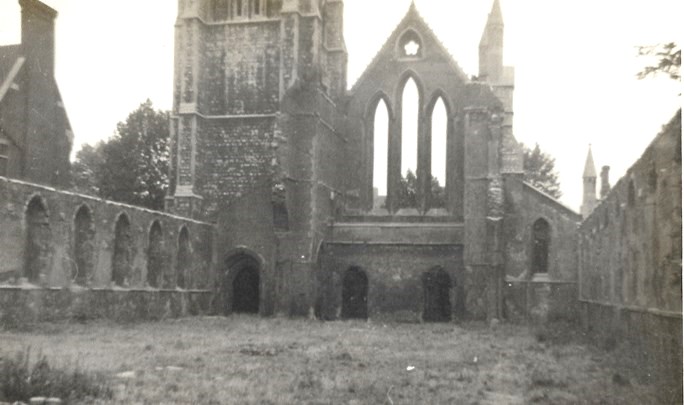ST. MARY'S NEWINGTON
Kennington Park Road, London


The roofless shell, through bombing, was the fate of many a Southwark church, during the blitz. The fire bombs destroyed the church on the 10th May 1941. This picture was taken by me, circa 1954, before the new building was started. The space within the Kentish ragstone walls was often used in the 1950s for summer fairs, bomb-fires, and by the Boy Scouts, Cubs, Girl Guides and so on. The 1876 Early-English Revival western tower and façade, still survive to this day. A reminder of the unprecedented days of the Second World War, and a tribute to the Architect, James Fowler.
A member of the clergy, perhaps a Deacon or Curate, (Harry Christopher Hurford Veazey ?) who had been at St. Mary’s Newington, told me in the 1960s, that he had run into the burning church. He managed to save the large brass cross from the altar. This continued to be used at St. Mary’s during services, first in the converted Church Hall, and from circa 1958 in the new building.
Later he was the incumbent at the church of ‘The Beheading of John the Baptist’, Doddington, Kent. There was a historical connection between the two parishes, and for several years there was an annual coach trip to Doddington. This was on the date when the gardens of Doddington Place were open for the village fair. For the Londoners there was tea at the vicarage, church services at Doddington and on one occasion at St. Catherine, Kingsdown. There was even a tug-of-war between the men from Southwark, and the men from Doddington. The latter always won!
The Spacious, London, tree-lined Doddington Grove, in Walworth is named after Doddington in Kent, where Sharsted Court was once the home of the ‘Faunce De Laune’ family. Formerly the family at Sharsted Court held the land in Newington (Walworth). Hence, the street names near Braganza Street; De Laune Street, Sharsted Street and Faunce Street as well as Doddington Grove.
/+\